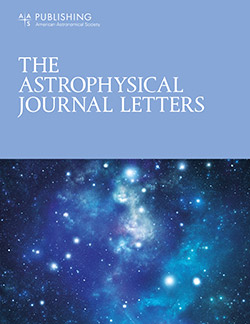类02s型Ia型超新星2022ywc中前所未有的早期通量过剩表明与星周物质的相互作用
IF 8.8
1区 物理与天体物理
Q1 ASTRONOMY & ASTROPHYSICS
引用次数: 0
摘要
摘要:本文报道了类02s型Ia超新星(SN) 2022ywc的光学光度和光谱观测结果。这一瞬变发生在一个椭圆宿主星系的外围,并显示出一个引人注目的双峰光曲线,在ATLAS橙色和青色波段检测到早期的过量特征。早期的过剩非常明亮,绝对星等为~ - 19,与随后的放射性驱动的第二峰的光度相当。它的光谱类似于超新星SN 2016jhr,它被认为是氦壳爆炸的候选者。我们研究了不同的物理机制,可以为这种突出的早期过剩提供动力,并排除了巨大的氦壳爆炸,表面56 Ni分布和抛射-伴生相互作用。我们得出的结论是,SN喷出物与星周物质(CSM)相互作用是最可行的方案。MOSFiT半解析模型表明,SN抛射物在~ 10 ~ 14 cm距离上与CSM的~ 0.05 M⊙相互作用可以解释异常光曲线。双简并情景可以解释CSM的起源,从次级白矮星上潮汐剥离的物质或在次级白矮星分裂和吸积后沿极轴发射的盘状物质。非球形CSM结构可能表明,沿着有利的视线观察,一小部分类似02的事件可能会显示出非常明显的早期过剩,就像SN 2022ywc一样。本文章由计算机程序翻译,如有差异,请以英文原文为准。
Unprecedented Early Flux Excess in the Hybrid 02es-like Type Ia Supernova 2022ywc Indicates Interaction with Circumstellar Material
Abstract We present optical photometric and spectroscopic observations of the 02es-like type Ia supernova (SN) 2022ywc. The transient occurred in the outskirts of an elliptical host galaxy and showed a striking double-peaked light curve with an early excess feature detected in the ATLAS orange and cyan bands. The early excess is remarkably luminous with an absolute magnitude ∼ − 19, comparable in luminosity to the subsequent radioactively driven second peak. The spectra resemble the hybrid 02es-like SN 2016jhr, which is considered to be a helium shell detonation candidate. We investigate different physical mechanisms that could power such a prominent early excess and rule out massive helium shell detonation, surface 56 Ni distribution, and ejecta–companion interaction. We conclude that SN ejecta interacting with circumstellar material (CSM) is the most viable scenario. Semianalytical modeling with MOSFiT indicates that SN ejecta interacting with ∼0.05 M ⊙ of CSM at a distance of ∼10 14 cm can explain the extraordinary light curve. A double-degenerate scenario may explain the origin of the CSM, by tidally stripped material from either the secondary white dwarf or disk-originated matter launched along polar axes following the disruption and accretion of the secondary white dwarf. A nonspherical CSM configuration could suggest that a small fraction of 02es-like events viewed along a favorable line of sight may be expected to display a very conspicuous early excess like SN 2022ywc.
求助全文
通过发布文献求助,成功后即可免费获取论文全文。
去求助
来源期刊

Astrophysical Journal Letters
ASTRONOMY & ASTROPHYSICS-
CiteScore
14.10
自引率
6.30%
发文量
513
审稿时长
2-3 weeks
期刊介绍:
The Astrophysical Journal Letters (ApJL) is widely regarded as the foremost journal for swiftly disseminating groundbreaking astronomical research. It focuses on concise reports that highlight pivotal advancements in the field of astrophysics. By prioritizing timeliness and the generation of immediate interest among researchers, ApJL showcases articles featuring novel discoveries and critical findings that have a profound effect on the scientific community. Moreover, ApJL ensures that published articles are comprehensive in their scope, presenting context that can be readily comprehensible to scientists who may not possess expertise in the specific disciplines covered.
 求助内容:
求助内容: 应助结果提醒方式:
应助结果提醒方式:


